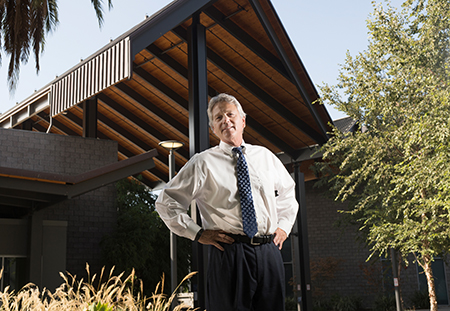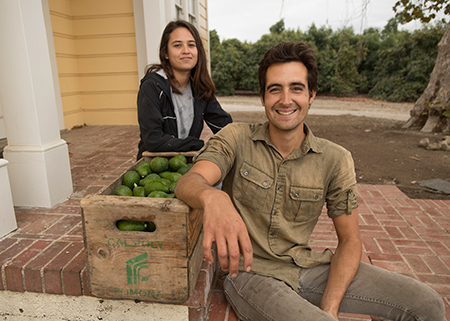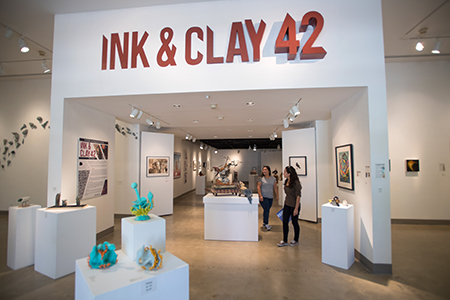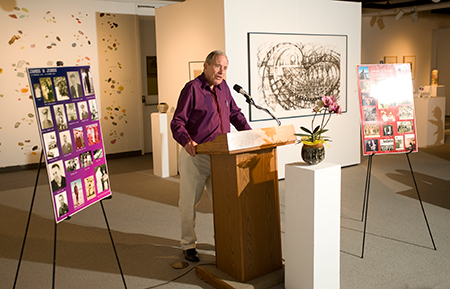Friends in Deed
Donors Make a Vital Impact on Cal Poly Pomona Students and Programs
By Gary Fong
Friends of the university make things happen — they open doors to prized internships, advocate for the university and sponsor valuable programs on campus.
John Tush, Lee Cole and Bruce Jewett are not graduates of Cal Poly Pomona. But as friends of the university — in some cases by happenstance — they have made an indelible impact on the lives and success of students, and enhanced educational opportunities. The common thread is a belief in the transformative power of a Cal Poly Pomona education.
“Friends of the university are more than donors. They are loyal and committed partners who have a passion for Cal Poly Pomona and what it stands for,” says Rick Nordin, interim associate vice president for University Development. “Without these kinds of friends and what they bring to the table, some of the vibrant learning opportunities for our students would not exist.”
BUYING IN
John Tush practices what he preaches: Take the initiative.
 |
| John Tush is the senior partner at Access Partners in Azusa. |
The senior partner at Access Partners, a sales agency that pairs food container manufacturers with restaurant chains and suppliers, approached Cal Poly Pomona in 2014 about creating a scholarship for students in the College of Business Administration.
“I always said that when I retired I was going to do it,” says Tush, who lives in Pasadena. “The scholarship part of it, as it turns out, was secondary. I started to see what the kids really needed.”
At that initial meeting two years ago, he pledged $136,500 through the Access Partners Foundation to fund scholarships. He also became the college’s executive-in-residence in 2014, and he says it’s not uncommon to see students lined up outside his office seeking his counsel. He has much insight to share from a nearly 40-year career in sales.
Tush has become a conduit for sales internships and jobs. He helps students refine their resumes and teaches them how to interview for jobs, and says his track record for helping students
land internships and jobs is “close to 100 percent.”
Shortly after he arrived on campus as the executive-in-residence, Tush sat in on a marketing class and students were asked to introduce themselves. One student said that he worked 32 hours a week as the overnight manager at a fast-food restaurant while carrying 16 units and relying on copious amounts of coffee to help him get through the day.
That story of working and going to school resonated with Tush, and a few weeks later he contacted Nick Gable (’16, marketing) to interview for an internship at Access Partners. That yearlong internship would be the springboard for Gable, who also took a full course load during those quarters. Gable is now an outside sales representative for Los Angeles-based Trade Supplies, which specializes in disposable food-service packaging.
“When I wake up in the morning, I don’t see it as work. Sales is all about making relationships with people and it’s something I enjoy and want to do for a very long time,” Gable says. “I’m really thankful for John helping me to realize that this is what I was meant to do and really pushing me along that path to get me to where I am.”
DEEP ROOTS
Long before Pine Tree Ranch was deeded to Cal Poly Pomona in 1976, Lee Cole worked its 53 acres in Santa Paula when he was in high school, oversaw farming operations for owner Carlton Wasmandorff and later lived in the ranch house.
Cole recalled that he and Wasmandorff would ride tractors to clear boulders so that avocado and citrus groves could be planted. Over the years, Cole would become a good friend and confidante of Wasmandorff.
 |
| Pine Tree Ranch in Santa Paula was deeded to Cal Poly Pomona in 1976. |
In the mid-1970s, Wasmandorff wanted to give his ranch to an institution that would educate and train agriculture students. Eventually, he decided to will his ranch to Cal Poly Pomona.
Internships at the ranch started in 1977 and lasted until 2003, when the effects of a deep recession were felt. Last year, Mary Holz-Clause, dean of the College of Agriculture, approached Cole about helping to restore the ranch house. Although Cole had not been involved with the ranch for some time, he didn’t hesitate.
Cole’s life and success as an avocado grower are intertwined with the ranch. As the CEO of Calavo Growers, Cole asked the board of directors for approval for a $100,000 gift to refurbish the house.
“I have a deep connection to the ranch and I was more than happy to help,” says Cole, who owns property nearby. “Anything that has to do with agriculture I am definitely a supporter, and that’s what Cal Poly Pomona represents.”
Pine Tree Ranch will again host internships for Cal Poly Pomona agriculture students, giving them hands-on learning experiences.
“We will bring plant science and agribusiness students back here again to learn how to manage our citrus and avocado orchards,” Holz-Clause says. “Together with our industry partners, our faculty and staff will help Pine Tree Ranch thrive again and become a valuable cornerstone to the learn-by-doing philosophy at Cal Poly Pomona.”
As a CEO, Cole also knows that brand awareness is vital. He wants to see agriculture and Cal Poly Pomona go hand in hand in Ventura County.
“I can’t say strongly enough how important it is to have the Cal Poly Pomona brand back up here,” Cole says. “Kids go by and see the Cal Poly Pomona name on the house. Right away that’s where they’re going to check first about going to college.”
THE ART OF GIVING
 |
| Established in 1971, Ink & Clay is a national competition that features works that incorporate “any variety of ink or clay as a material.” |
 |
| Bruce Jewett has given annually to the Ink & Clay exhibition. |
Bruce Jewett feels at home when he’s at Cal Poly Pomona, especially when it’s time for the annual Ink & Clay art exhibition.
His partner, the late Lt. Col. James “Jim” H. Jones (’51, citrus fruit production), funded an endowment in 1971 for the initial Ink & Clay exhibitions. Jones was a U.S. Air Force officer who was stationed at posts across the Middle East during the Cold War.
“Every time Jim changed stations, he would buy some new art to decorate his quarters,” Jewett says. “When he changed stations on several tours, he would take all the old artwork to Cal Poly Pomona and started a collection.”
Jewett’s own passion for art blossomed through association. “I hadn’t really been into visual art until sort of by osmosis from Jim’s interest and activities,” recalls Jewett, who also is a devotee of the performing arts.
Jewett has seen the exhibition grow from a small show of works by art department faculty members to a regional showcase to a juried competition that attracts artists from across the nation. He began providing support to the exhibition after witnessing the passion of those who have made the show a success year after year.
“I was really impressed by the staff and faculty. Everyone seemed to be enjoying their job,” says Jewett. “The whole atmosphere at Cal Poly Pomona is like a family. They enjoy what they are doing.”
Affirming his belief in the university, Jewett has issued a bequest to Cal Poly Pomona. He gives annually to Ink & Clay and the James H. Jones Memorial Purchase for the exhibition, and has supported other art-related programs in the College of Environmental Design.
“Bruce Jewett’s generous support is essential to the running of Ink & Clay. His contributions, as well as the endowments set up by himself and the late great Col. James Jones, make this campus tradition happen,” says Michele Cairella Fillmore, curator of the W. Keith and Janet Kellogg University Art Gallery and the Huntley Art Gallery. “Ink & Clay gives national recognition and notoriety to Cal Poly Pomona.”
Aside from being a showcase for intriguing art, the Ink & Clay exhibition and other forms of art offer a different yet equally valuable dimension to academics.
“It is very important to support the arts,” Jewett says. “Anything students can do outside of their specific major makes them a broader person.”
